Tom Phillips / Gavin Bryars / Fred Orton
IRMA AN OPERA BY TOM PHILLIPS
(LP)
12 Inch LP

Neo-Classical, Minimal, Avantgarde, Reissue
On composing Tom Phillips' Irma
In February and March of 1977, for Brian Enos Obscure Records, I made a version of Irma. The following notes on the piece arise out of that involvement and try to show how the piece can be made into a performance state.
Irma is a curious score it is printed on a single sheet 50cms x 50cms. The notation consists of fragments from Toms continuing treatment of the victorian novel by W. H. Mallock, which he calls A Humument, and utilises those short verbal fragments that refer to either libretto, decor and mise-en-scène or sounds. These 3 categories are arranged in separate sections on the square sheet with, at the bottom, a line of stave notation. At first sight it looks like a piece of indeterminate music clearly there has to be some preparatory work done before it is performable and no-one would venture to perform directly from the score - but if it is approached in this spirit, like realising a piece by John Cage or Morton Feldman written during the 1950s, the sounding results are either largely of a documentary
interest, or rely entirely on the gifted performer to make into a coherent sounding whole. True, one could say the same thing for a piece by Cage, such as Variations I, but there the
performer is given a number of precise parameters of sound within which he should work, whereas Irma needs to be re-composed rather than realised.
If the distinction between composing and realising is overlooked, and if only the materials present in the notation are used, then the result is likely to be impoverished and it is clear that, looked at in isolation as a self-contained work, the score is notationally very thin. So one either produces an impoverished piece of sounding music, or one takes the responsibility to look further. Tom does not say explicitly that one must go beyond Irma into the rest of his work, but he does say that one has to go outside the piece. On the score he writes: Perhaps to treat the indications here given as if they were the only surviving fragments of an ancient opera, or fragments of eye and ear witnesses accounts of such, and given no knowledge of performance tradition of the time, to reconstruct a hypothetical whole which would accommodate them economically, would be an appropriate basis of approach to a production. So, try to put it back together and try to fill in all the gaps between these fragments. This approach, which, incidentally coincides with an interest in such procedures within my own work, seems to be the most suitable. If the composer uses the sorts of methods that Tom evidently uses in producing pictures, in making A Humument (of which Irma is a part), and if he uses the notations of Irma as clues to lead him into whatever area seems likely to yield rich results, then a much more satisfactory outcome is likely satisfactory both in terms of the quality of the sounding material and in terms of consistency with the rest of Toms oeuvre. .......continue[info sheet from distr.]